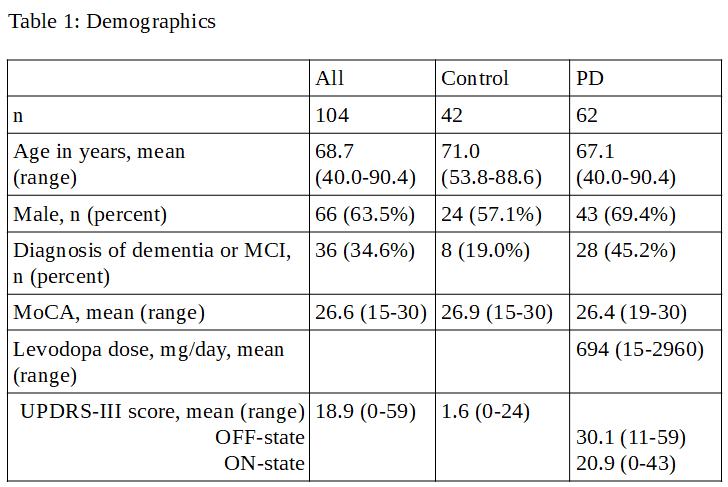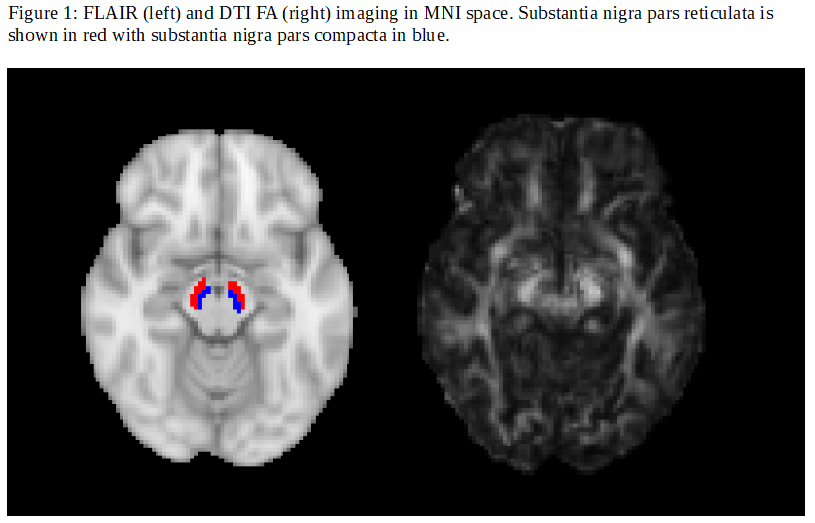Category: Parkinson's Disease: Neuroimaging
Objective: To study the correlation between substantia nigra white matter integrity and response of motor symptoms to dopamine replacement therapy (DRT) in Parkinson’s disease (PD).
Background: Low fractional anisotropy (FA) measured with diffusion tensor imaging (DTI) is associated with reduced white matter integrity, axonal loss, and demyelination [3]. Low FA in a variety of brain regions including substantia nigra (SN) is associated with severity of symptoms in PD [3]. Other studies have shown a longitudinal association between nigral FA and disease severity in PD [1,2] and DRT use and preservation of nigral FA early in the disease course [3]. We hypothesize that immediate motor symptom improvement with DRT in PD is associated with higher nigral FA, particularly in the pars compacta.
Method: Cohort included 62 PD patients and 42 controls enrolled in the Pacific Udall Center who underwent 3T MRI and detailed cognitive and motor assessments including the Montreal Cognitive Assessment (MoCA) and Part III of the Movement Disorder Society Unified Parkinson’s Disease Rating Scale (UPDRS-III) [table1]. The T1 images were used for registration [table2]. We performed motion correction and distortion correction for DTI data and weighted-least-squares diffusion tensor fitting using the FMRIB’s diffusion toolbox to obtain fractional anisotropy (FA) values. Lateralized substantia nigra pars compacta (SNPC) and substantia nigra pars reticulata (SNPR) regions of interest were identified using the AAL atlas [figure1]. We correlated FA values to MoCA scores, dUPDRS (difference in UPDRS-III scores between the OFF and ON state), and levodopa equivalent daily dose (LEDD).
Results: FA values in SNPR and SNPC were not significantly different between PD patients and controls (p=0.236, 0.274). We found significant correlation between dUPDRS and FA values in the PD patients in SNPC (r=0.226, p=0.039), but not in SNPR (p > 0.05). No correlation was found between FA and MoCA scores or LEDD (p > 0.05).
Conclusion: These results suggest that white matter integrity in SNPC is correlated with clinical response to DRT in PD. Additional studies are needed to confirm this effect. Our study is limited by inclusion of few unmedicated PD patients and did not account for time since diagnosis. Given relative preservation of nigral FA in medicated early PD patients, this may explain similar nigral FA between our groups [3].
References: [1] Mishra VR, Sreenivasan KR, Zhuang X, Yang Z, Cordes D, Walsh RR. Influence of analytic techniques on comparing DTI-derived measurements in early stage Parkinson’s disease. Heliyon. (2019) 5:e01481. doi: 10.1016/j.heliyon.2019.e01481 [2] Taylor KI, Sambataro F, Boess F, Bertolino A, Dukart J. Progressive decline in gray and white matter integrity in de novo parkinson’s disease: an analysis of longitudinal parkinson progression markers initiative diffusion tensor imaging data. Front Aging Neurosci. (2018) 10:318. doi: 10.3389/fnagi.2018.00318 [3] Zhang Y, Burock M. Diffusion tensor imaging in Parkinson’s disease and Parkinsonian syndrome: a systematic review. Front Neurol. (2020) 11:531993. doi: 10.3389/fneur.2020.531993
To cite this abstract in AMA style:
S. Atkinson, R. Seo, D. Peterson, B. Cholerton, SC. Hu, T. Montine, T. Grabowski, C. Zabetian, S. Rane. Substantia nigra pars compacta integrity is associated with DRT-related motor symptom improvement in Parkinson’s disease [abstract]. Mov Disord. 2021; 36 (suppl 1). https://www.mdsabstracts.org/abstract/substantia-nigra-pars-compacta-integrity-is-associated-with-drt-related-motor-symptom-improvement-in-parkinsons-disease/. Accessed January 2, 2026.« Back to MDS Virtual Congress 2021
MDS Abstracts - https://www.mdsabstracts.org/abstract/substantia-nigra-pars-compacta-integrity-is-associated-with-drt-related-motor-symptom-improvement-in-parkinsons-disease/



